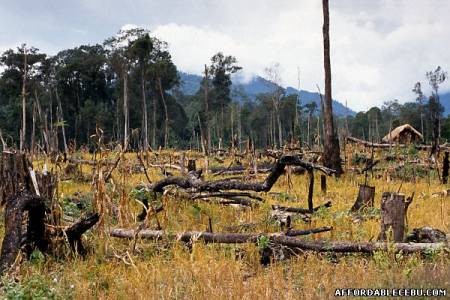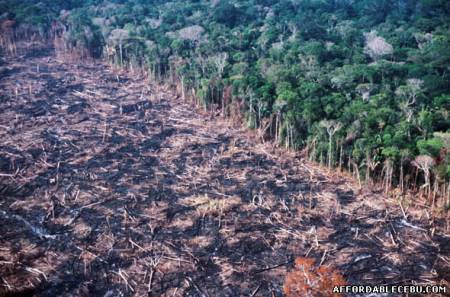OVERVIEW
Deforestation, the large-scale removal of forest, prior to its replacement by other land uses. Estimates for the annual rate of global deforestation at the end of the 20th century and the beginning of the 21st century vary from about 1.5 million hectares (3.7 million acres) to about 31 million hectares (78 million acres), although a figure of about 7.5 million hectares (18 million acres), an area larger than England, Wales, and Northern Ireland combined, was widely accepted in the 1980s and 1990s.
While deforestation is now viewed as a problem, historically it was considered to assist national development. Natural forest "capital” was liquidated and replaced by other forms of capital to produce food, raw materials, energy, or infrastructure.
Deforestation processes are, in general, more destructive in the tropics. Most forest soils in the tropics are far less fertile than temperate soils, and are erodible. This is because high rainfall leaches out nutrients from the soil, preventing them from building up. However, colonial policies were based on the mistaken assumption that lush forests were on fertile soils. They aimed to "conquer” the forests, principally for cash crop plantations and agriculture; and have left a legacy of exhausted soils.
Tropical deforestation increased rapidly after 1950, helped by the availability of heavy machinery. Since then, rising human populations have also cleared forests the hard way—by hand. Annual rates of deforestation in 52 tropical countries nearly doubled from 1981 to 1990.
MODES OF DEFORESTATION
Slash-and-burn cultivation by small-scale farmers is a particularly common form of tropical deforestation in Africa and south-eastern Asia. After a few years' cropping, many soils support only grassland and scrub, and farmers move to other forests.
Timber harvesting is a significant cause of deforestation in south-eastern Asia, Central Africa, and—until about 1990—West Africa. Logging frequently damages more trees than it removes. Timber production in the Pacific Northwest of North America, and in Siberia, often replaces tree cover through plantations (see below), or leaves the area to regenerate naturally through the process of succession (see Ecology), although soil degradation and erosion take place while the plant community is being re-established.
Clearance for settled agriculture, on infertile soils, results in short-term gains only. However, well-planned clearance has led to sustainable benefits, such as some rubber and oil palm plantations, which retain a forest-type structure aiding soil and water conservation.
Clearance for forest plantations has been significant in south-eastern Asia and South America. Foresters worldwide have removed natural forests to make way for plantations that are higher-yielding in timber production. However, there is now more awareness among foresters of the social and environmental losses arising from this. Forest plantations, since they often contain single species of tree all of the same age, do not reproduce the ecosystem of the original forest, which is generally characterized by a wide variety of flora and fauna at all stages of development. Clearance for grazing has been a major cause of deforestation in Brazilian and Central American forests, with government-sponsored schemes to create large ranches. Regular woodland burning to maintain pasture is common in dryland Africa.
Clearance for fuelwood is a problem in the drier areas of Africa, the Himalaya, and the Andes.
Clearance for settlement, mining, and oil exploitation are locally significant, notably the organized transmigration schemes operated, until recently, in Indonesia and Brazil, where people from overcrowded areas were settled by governments in forests.
Clearance for Forest Plantations Clear-cutting is a forestry technique in which all the trees in a given area are removed. The advantages of this technique (providing the clear-cut area is replanted) include the eventual production of trees of approximately the same age and height, which are easy to harvest using mechanized equipment. The disadvantages include the elimination of old growth forest and animal habitat, excessive erosion, and an unattractive landscape.Oxford Scientific Films/Mike Birkhead
Clearance for roads and dams has directly resulted in deforestation.
Often, several deforestation agents work sequentially. Road development encourages timber exploitation, which opens the forest for agricultural settlement and fuelwood salvaging. About half of all logged tropical forests are eventually used for farming.
Deforestation and forest degradation occur in response to policy, market, and institutional "signals”. These tend to either "push” people into the forest, through difficult economic or social conditions outside it; or to "pull” people into the forest, through the attraction of profits (from logging or forest clearance). Many policies effectively undervalue forests, such as low fees for logging, or they overvalue the benefits of removing forest for other uses, which can be seen in the subsidization of food prices. In contrast, they do not provide long-term incentives to look after forests. The lack of security of forest ownership and forest-use rights encourages exploitative behaviour.
APPROACHES TO CONTROL DEFORESTATION
Traditional approaches to forest problems have emphasized laws and regulations. But these are often weakly enforced, and stronger groups are able to evade them. In poor countries, focus has been on aid-funded programmes, notably the international Tropical Forests Action Programme. These have proved insufficient to reduce deforestation. They have not tackled the root causes. Market-based, voluntary approaches are now appearing—such as forest certification and timber labelling—to favour the products of sustainable forest management.
There is now general agreement that, as deforestation is the result of many direct actions triggered by various root causes, action on only one front rarely solves the problem. Many efforts are required to encourage sustainable forest management, balancing environmental, social, and economic objectives. Critical are certain national procedures and policies. Since deforestation can produce both benefits and costs, it is important to estimate the gains and losses for each possible forest removal. The United Nations has recommended that every nation preserve at least 12 per cent of its representative ecosystems. Several countries are valuing forest benefits, and defining a Permanent Forest Estate (PFE) and standards for its use. The PFE is the amount and location of forest a nation decides it needs, now and for the future, for both protection and production purposes. Remaining forests are planned for eventual conversion to other land uses.
- https://www.affordablecebu.com/

